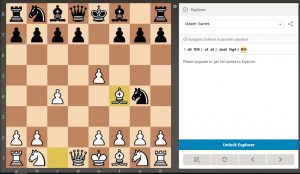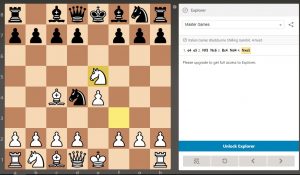The Suffocation mate is a common method of checkmating. It works by using the horse to attack the enemy king and the bishop to close the escape routes of the king.
Sometimes it is confused with the Smothered mate. The difference is that a smothered mate is a method of checkmating that takes place when a knight checkmates a king that is surrounded by his friendly pieces and he has nowhere to move and no way to capture the knight that is delivering the checkmate.
A smothered mate may be possible in the opening of a game. One of the most famous, and most frequently occurring, is in the Budapest Gambit. It arises after 1. d4 Nf6 2. c4 e5 3. dxe5 Ng4 4. Bf4 Nc6 5. Nf3 Bb4+ 6. Nbd2 Qe7 7. a3 Ngxe5 8. axb4?? Nd3#. Note that the knight cannot be taken because the pawn on e2 is pinned to the white king by the black queen on e7.

In the picture is it shown until the 4th move, the Bf4.
Personally, I don’t play this variation too often, I find it a bit complicated to remember. Though when it is played against me I am spending a bit more time than I would like thinking about it and all it’s variations. It is an opening that is not very often used, therefore, when I happen to come across it, I remember vaguely how it works, but I still prefer to be on the safe side and not fall into a trap.
A lot of times, I fell for this opening: 1. e4 e5 2. Nf3 Nc6 3. Bc4 Nd4?! 4. Nxe5!? Qg5! 5. Nxf7?? Qxg2 6. Rf1 Qxe4+ 7. Be2 Nf3#. Somehow, I know it and I can recognize it when I see it during other people’s games, but when I am playing against white with this opening, my greedy voice shows up and tell me to capture the pawn with the knight and end up in the terrible position from the picture below.

It’s black’s move and the follow-up from this position will be with a queen to G5 making a double-threat to the pawn on G2 and the knight on E5. At this point, the position is hard to recover and white will be forced to decide whether to go further with the knight and capture the F7 pawn or retreat it to F3 thus allowing the queen to capture the G2 pawn. At this point, it is very important to keep in mind that the queen’s most important role is to protect the C2 pawn from the Knight on D4. If white allows the pawn capture with the knight from D4 then that would be check with a fork the rook and would also stop white from castling.
These position that I have just presented can lead, one way or another, to a Smothered mate or a checkmate by Suffocation. Next time that you might come across them, keep in mind that there is more than just one way to reach these positions and even though they could vary a bit, depending of every game, the consequences and making a mistake in these kind of positions can cost the players the game.
This type of openings are not played too often but every player still needs to be prepared to know how to answer to them when they finally find themselves in the situation.



